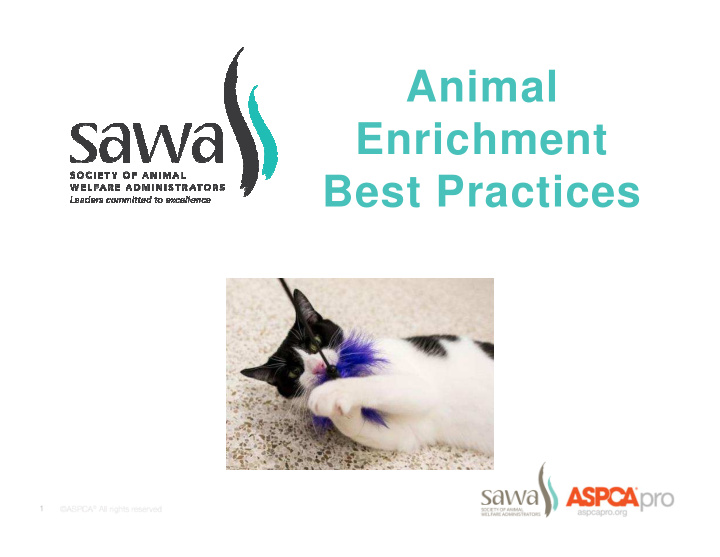



Animal Enrichment Best Practices 1
Presenters Brad Shear, CAWA Executive Director Potter League for Animals Allison Hartlage , CTC, KPA-CTP, CPDT-KA, CNWI Manager of Training & Behavior Humane Society of Boulder Valley 2
Best Practices Defined SAWA’s Approach to Best Practices Best Practice vs Minimum Standards 3
Enrichment Defined A process for improving the environment and behavioral care of confined animals within the context of their behavioral needs 4
Poll 5
Purpose of Enrichment • Reduce stress • Increase behavioral health • Decrease illness • Reduce length of stay 6
Importance of Enrichment Mitigate the development and expression of abnormal and/or problematic behavior and contribute to the overall wellbeing of the animals 7
History of Enrichment: Five Freedoms 1. Freedom from hunger and thirst 2. Freedom from discomfort 3. Freedom from pain, injury or disease 4. Freedom to express normal behavior 5. Freedom from fear and distress 8
Limitations of Enrichment • The shelter is not home. • Long-term or lifetime housing is not recommended. 9
Enrichment vs. Behavior Modification 10
Enrichment = Prevention • Mitigate stress • Prevent behavioral deterioration • Increase emotional wellbeing • Strengthen resilience and adaptation to the shelter environment • Foundation for psychological health during shelter stay 11
Behavior Modification = Treatment • The process of changing an animal’s behavior • Works toward altering an animal’s problematic behavior • Often resource intensive and requires staff with a specialized skill-set 12
Key Considerations 13
Key General Tips for Success Considerations •Beware of overstimulation •Consider individual preferences •Provide variety •Keep it positive 14
Special Considerations for Individuals • Stress and fear • Reducing stimulation can be as important as increasing stimulation • Safety for staff and other animals • High energy dogs 15
Sanitation and Safety • Disinfection of items and areas • Monitor individuals • Safe animal handling skills • Protective equipment • Follow restricted diets • Follow medical protocols 16
Goals and Outcomes 17
What should you expect to invest? 1. Staff training 2. Financial investment 3. Staff time for implementation and oversight 18
What are the potential benefits? 1. Reduction of stress 2. Reduction of behavioral deterioration 3. Reduction of illness 4. Reduction of length of stay 5. Present better for adoption 6. More engaged and observant workforce 7. Improvement of overall QOL 19
What are the measures we may be able to observe? 1. Reduction of behaviors that indicate stress, fear or boredom 2. More animals exhibiting relaxed body postures, calm demeanor, normal sleep patterns and interest in social interaction 3. More animals coping well with their environment 20
Monitoring the Effectiveness of Enrichment 21
Observe and Record • Item use? • Good behavior and body language • Signs of stress: up or down? No thanks. 22
Good Signs •Good appetite •Body language indicating lack of stress •Healthy species-specific behavior •Normal grooming behavior •Normal activity level •Sociability •Sleep/rest •Play 23
Bad Signs •Poor appetite •Fearful/anxious body language •Retreat or hiding •New aggressive behavior or reactivity •Inactivity •Hyperarousal •Compulsive behavior •Social withdrawal •Physical ailments (e.g., diarrhea) 24
When and How Schedule regular assessments � Individual level � Programmatic level •Include all 4 steps 1. OBSERVE 2. RECORD 3. REVIEW 4. ADJUST 25
General Components and Requirements 26
Enrichment Basics • Starts at intake • Provided daily • Structured but with room for flexibility and individuality 27
Our Requirements � Comfortable resting area � Hiding spot (especially cats) � Things to chew (dogs) � Scratching surfaces (cats) � At least one toy, rotated daily � Daily social interaction � Daily sensory enrichment � Daily mental stimulation � Regular physical exercise � Exposure to enjoyable novelty 28
Contact Information Brad Shear: BradS@potterleague.org Allison Hartlage: Allison.Hartlage@boulderhumane.org 29
SAWA Enrichment Best Practice Committee Kelley Bollen David Williams Allison Hartlage Dr. Graham Kristen Collins Brayshaw Ana Zorrilla Jerrica Owen Beau Archer Jon Cicirelli Brad Shear Martha Boden Cary Lieberman Vicki Davis Courtney Thomas 30
Resources www.sawanetwork.org/page/ Resources Select Animal Enrichment Best Practices 31
SAWA Best Practices Webinar Series: Animal Enrichment aspcapro.org/animal-enrichment-webinar-series • How to Plan & Track the Best Enrichment Program Ever Wednesday, January 24, 3-4 pm ET • The 8 Components Every Animal Enrichment Program Should Have Wednesday, February 7, 3-4 pm ET • Do Try This At Home: Cheap & Fun Enrichment Ideas for Shelters Wednesday, February 21, 3-4:30 ET 32
Recommend
More recommend